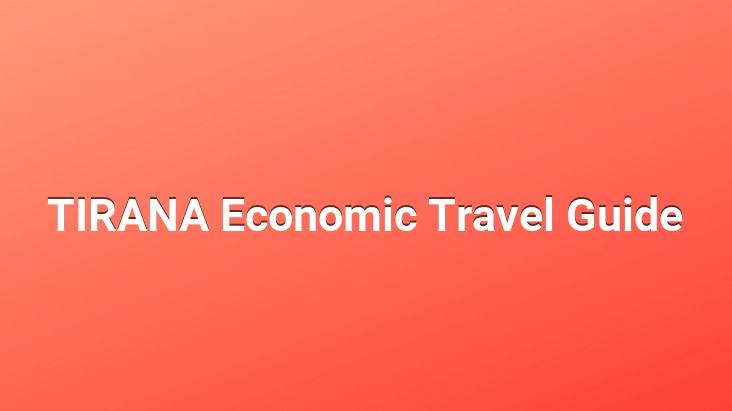TIRANA Economic Travel Guide
The capital city of Albania, Tirana, is the only one in the top 10 in the list of the cheapest cities in the world. capital. In addition, another feature is that it is the first atheist country in the world.
Although Albanian dishes come to mind first when Albania is the last piece of land that remained under the Ottoman Empire for 500 years and broke away from the Ottoman Empire, we should also mention Enver Hoxha. must. Enver Hoxha, who came to the head of Albania in 1946, made radical changes in the country.. II. He secured the country’s borders after World War II, and established close relations with Russia and China during the Stalin era.. Not on good terms with Yugoslav leader Tito. He sentenced to death the opponents who thought that they should join Yugoslavia and almost closed the country’s doors to the outside world.. With the idea that they could be self-sufficient, they made the people prosperous for a while, but then went completely ridiculous.. After his death in 1985, the people officially celebrated and he is still hated.
There are not many places to see in Tirana, everything is gathered around a street. You can eat plenty of meat and fish in this city, and you can sit back and watch this colorful but sad city at the places we recommend below.
Albanian currency: Leke. 1 Stain = 0.062 TL (August 2018)
Albania weather: All four seasons are experienced. But our advice is to go in the spring.. Because the Balkans is very crowded, especially in summer.
TRANSPORTATION TO TIRANA: HOW TO GET TO TIRANA?
By Plane: Tirana Airport (Tirana International Airport Nënë Tereza) ) from Istanbul or Antalya to Tirana with Pegasus or THY.
By Bus: You can find buses within the country in Albania.. Prices are more reasonable, but if you want to go from Tirana to Saranda for long distance, you have to pay between 1,000 and 1,200 lek.. Click to see bus times and where there are buses
By minibus: Not recommended. They were flexible in terms of price and time.
By Train: You can easily travel within Albania by train. Click to see train times and where there are trains
INTERNATIONAL TRANSPORTATION IN TIRANA
You will not need a car during your trip to Tirana. Because all the places to visit in Tirana are close to each other.. If you say you must take public transportation, you can buy a ticket for 40 Leke and get on one of the 20 bus lines between 06:00-23:00.. Since there is not a bus station in Tirana yet, you can take whatever you find.. Also, taxi can be another option.
ACCOMMODATION IN TIRANA: WHERE TO STAY IN TIRANA?
Tregu Pine Region can be preferred.
THAT SHOULD BE DONE IN TIRANA?
Travel to the Dajti Mountains by cable car: 25 km from Tirana, Mount Dajti has the longest cable car in the Balkans.. You can go up to 800 meters and watch Tirana.. You can reach the mountain for 30 Lek by bus called Linzi.. Cable car ride takes 15 minutes. Fee: 800 Lek round trip. Click for detailed information
Spending time in Taiwan and B Block region: You can choose to see a different side of Tirana and to immerse yourself in the flow of time and eat delicious meals.
Tasting Albanian dishes..
WHAT TO EAT IN TIRANA? WHAT TO DRINK?
- Elbasan pan and
- Fergese: Juicy Albanian liver
- Kalmaçina: Creamy creme
- Chopping Cobblestone: Eggplant Sitting
Also, due to their close friendship and admiration for Italy, you can drink in a cafe and eat pasta and pizza here.
TIRANA SHOPPING IN TIRANA: WHAT TO BUY IN TIRANA?
Pottery, ceramics, silverware and traditional costume
WHERE TO SHOP IN TIRANA?
Wholesale Mall, you will see shopping malls from Myslym Shyri Street to Pine Street. Also, B Block will be attractive for design products.
TIRANA CITY TOUR
Dëshmorët e Kombit Boulevard (originally named Bulevardi Dëshmorët e Kombit) When you follow the left, you will actually have finished the must-see places in Tirana.. Our tour we prepared for Tirana travel guide, 4 km!
Click for map view of our Tirana walking route..
National History Museum Tirana: A gallery dedicated to the people who persecuted under the communist regime. An exhibition covering the Post-communist era from Old Illyria.. Almost none of the visual elements have English descriptions. A copy of Alexander’s gigantic sword in Albania’s biggest museum. was built.
Iskender Bey Square (The Skanderbeg Square): The square with an area of 40,000 m2, is the symbol of Albania. The nickname Alexander was given to the national hero Gjergj Kastrioti (or George Castriot, 1405-1468) for leading the rebellion against the Ottoman Empire.. Even the communist authorities expressed their respect for him.. The 11-meter-tall equestrian statue was celebrated at the 500th anniversary of his death in 1968.. To commemorate the anniversary, it replaced the statue of Stalin.
Historical Clock Tower (Kulla e Sahatit): Located right in front of the mosque. It was built in 1822 by Hacı Ethem Bey with Ottoman architecture.. The 35-meter-high tower was the tallest structure in Tirana at the time it was built.. You can climb the 90-step ladder to the top of the tower and watch the city.
Ethem Bey Mosque (Et’hem Bej Mosque): The construction of this mosque was started by Molla Bey in the 1790s, and was completed by his son Hacı Ethem Efendi in 1820.. It was closed during the communist regime, and on January 18, 1991, it was reopened for worship without permission.. When 10,000 people marched, the police didn’t stop them. It became the cornerstone of Albania’s freedom of religion that day.. Unlike Islamic art, the mosque has colorful frescoes on the outside and tree, waterfall and bridge motifs under the arches.
Tirana City Hall: The town hall right next to Ethem Bey Mosque
Kaplan Pasha Tomb (Tyrbja e Kapllan Pashes): The tomb, located behind Ethem Efendi Mosque, was classified as a first degree cultural structure by the Albanian government in 1948.
Parliament and Prime Ministry Buildings (Albanian Parliament) : Albania’s only parliament, the parliament
Rruga Murat Toptani: Pedestrian walkway between the Parliament Building and the National Art Gallery
Tanner’s Bridge: 18. The bridge for pedestrians, built during the Ottoman period in the 16th century, was once used as a connecting road connecting Tirana to the east of the city.. Vegetables and fruits were transported to the markets over the Lava River.
Piramida (Cultural Centre): The old mausoleum of Enver Hodja.. It is not used today due to the enmity of the people against Enver Hoxha.. It was even put up for sale but not taken. In front of the pyramid is the Peace Bell. The bell was made with bullets left over from the conflicts in the 1990s.
The Palace of Congress in Tirana: While hosting the congresses of the Albanian Workers’ Party in the last days of communism, today the annual Festival i Këngës and Kënga Magjike and It is used as a festival, concert and event space, especially the Tirana Book Fair.. In addition to the big hall with a seating capacity of 2100, there are also three small halls.
National Archaeological Museum of Tirana: The museum, located in Mother Teresa Square and opened in 1948,. It is the first museum to be opened after World War II.
Mother Teresa Square (Mother Teresa Square, ordinal sheshi Nënë Tereza): The second largest square in Tirana. It is named after a Roman Catholic nun of Albanian-Indian origin, who was awarded the Nobel Prize in 1979.. Mother Teresa was canonized on September 4, 2016. October 19 is a public holiday in Albania as Mother Teresa Day. To the southeast of the square is the statue of Mother Teresa.
Presidential Palace of Tirana: The mansion, which was previously used as the Royal Palace, is now known as the Palace of Brigades.. The Royal Garden draws attention with its beautiful landscape.
Block District (BLLOKU): Located opposite Taiwan, the region is considered Tirana’s most vibrant and popular entertainment venues.. Tirana’s best cafes, bars, restaurants, nightclubs are located here. You can choose it especially for nightlife and taking a break.. Zone B was the area where dictator Enver Hoxha’s villa was located.. In his government, this area was an area that only civil servants could enter. When B Block was opened to the public in 1991, people flocked to it.
Enver Hodja’s House: Enver Hodja lived in a simple three-storey villa in B Block for years.. After his death in 1985, his wife continued to live for a while.. The house is closed to the public.
Post Bllok Tirana (Postblloku = Checkpoint): Albania was conceived as an artistic installation of Communist isolation, political prisoners under the Hoxha regime.. made in memory of him. It was created by former dissident Fatos Lubonja and artist Ardian Isufi.
Taiwan and Rinia Park: The building, which stands out with its modern structure, has different places for eating, drinking and shopping.. It has an ideal location to take a break with the view of Rinia Park, which was organized in 2000.
If you have time and want to mingle with nature, we recommend;
- Great Park of Tirana or National park and Artifical lake: In the south of Tirana, close to Mother Teresa Square, the park has an artificial lake, botonic garden, walking areas, a zoo, and statues of people who have made a place in Albanian history.
- Park of Farka Artificial Lake: Capable of many sports activities , the nature area where tyrants go in their spare time.
- Paskuqan Park (Parku Paskuqan): Although the park in the north of Tirana complies with European standards, it still exists.. Besides many tree species such as lemon, orange, cherry, there are walking paths, flower gardens, playgrounds.
ENTERTAINMENT AND NIGHT LIFE IN TIRANA
Cafes, bars and night clubs in the B Block area are the choice of Tirana residents.. You can also have a sip while watching the panoramic view of Tirana from its 360-degree cafe at the Sky Tower Hotel.
OTHER PLACES TO VISIT NEAR TIRANA: ALTERNATIVE TOURS
- Petrela Castle: The castle, 15 km from Tirana, is located on the road to Elbasan.
- Pellumbas Cave: The cave, where there are horse remains of people dating back 300,000 years, is 350 meters deep in the mountain.. II. Used as a shelter during World War II.
- Spille Beach: 3 km long sandy beach south of Durrës.
- Durrës: You can visit this Adriatic port city with Roman and Byzantine heritage by buses that leave every 30 minutes. you can visit. 2. The largest amphitheater of the Balkans, dating back to the 19th century with a seating capacity of 20,000, is one of the must-see places in the city.
- Kruja: So Akçahisar.. 20 km north of Tirana, the first capital of Albania is also the hometown of Skanderbeg..
TIRANA TRAVEL NOTES
- <
- You can somehow handle the language problem with body language. They speak English, but it is necessary to explain a little head-to-head.
- Side cutters are trying a lot. We didn’t encounter any problems, but be careful.







